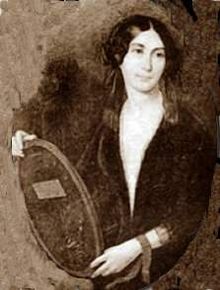
| French and Francophone literature |
|---|
| by category |
| History |
| Movements |
| Writers |
| Countries and regions |
| Portals |
Louise-Victorine Ackermann (néeChoquet) (30 November 1813 – 2 August 1890) was a French Parnassian poet.

| French and Francophone literature |
|---|
| by category |
| History |
| Movements |
| Writers |
| Countries and regions |
| Portals |
Louise-Victorine Ackermann (néeChoquet) (30 November 1813 – 2 August 1890) was a French Parnassian poet.
Ackermann was born in Paris, but spent her younger days in more rural surroundings near Montdidier, south-east of Amiens. In 1829, her father, having undertaken her early education, in the philosophy of the Encyclopaedists, sent her to school in Paris.
In 1838, Victorine Choquet went to Berlin to study German, and there married Paul Ackermann, an Alsatian philologist, in 1843. After little more than two years of happy married life her husband died, and Madame Ackermann went to live in Nice with a favorite sister. In 1855, she published Contes en vers, and in 1862, Contes et poésies. [1]
Very different from these simple and charming contes is the work on which Madame Ackermann's real reputation rests. She published in 1874 Poésies, premières poésies, poésies philosophiques, a volume of sombre and powerful verse, expressing her revolt against human suffering. The volume was enthusiastically reviewed in the Revue des deux mondes for May 1871 by Elme Marie Caro, who, though he deprecated the impiété désespérée of the verses, did full justice to their vigour and the excellence of their form. [1]
Soon after the publication of this volume Madame Ackermann moved back to Paris, where she gathered round her a circle of friends, but published nothing further except a prose volume, the Pensées d'un solitaire ("Thoughts of a Recluse", 1883), to which she prefixed a short autobiography. She died at Nice on 2 August 1890. [1]
Louise Ackermann's published works as cited by An Encyclopedia of Continental Women Writers. [2] : 2

Delphine de Girardin, pen name Vicomte Delaunay, was a French author.

Jeanne Lapauze, née Loiseau (1860–1920) was a French poet and novelist who used the pen name Daniel Lesueur.
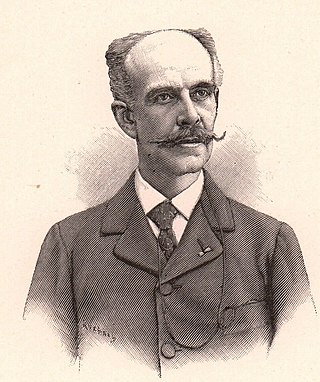
Gabriel Paul Othenin de Cléron, comte d'Haussonville was a French politician and author.
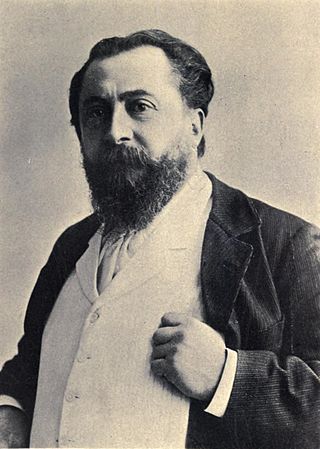
Catulle Mendès was a French poet and man of letters.

Marie-Catherine Le Jumel de Barneville, Baroness d'Aulnoy, also known as Countess d'Aulnoy, was a French author known for her literary fairy tales. The term contes de fées has been attributed to her, but her work was called "contes DES fées" ; the term "contes DE fées" comes from Mme de Murat's first fairytale compilation: "Contes de fées", published in 1698.

Paul Armand Silvestre was a 19th-century French poet and conteur born in Paris.

Victorine-Louise Meurent was a French painter and a model for painters. Although she is best known as the favorite model of Édouard Manet, she was an artist in her own right who regularly exhibited at the prestigious Paris Salon. In 1876, her paintings were selected for inclusion at the Salon's juried exhibition, when Manet's work was not.

Françoise de Graffigny, better known as Madame de Graffigny, was a French novelist, playwright and salon hostess.

Abel Hermant was a French novelist, playwright, essayist and writer, and member of the Académie française.
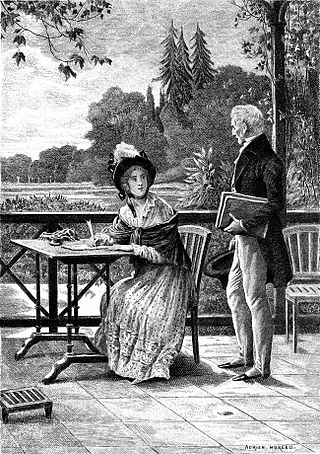
Mémoires de deux jeunes mariées is an epistolary novel by the French writer Honoré de Balzac. It was serialized in the French newspaper La Presse in 1841 and published by Furne in 1842 as the first work in the second volume of Balzac's La Comédie humaine. It was dedicated to the French novelist George Sand. The 1902 English translation of the novel included a preface by Henry James.

Julia Daudet, born Julia Allard, was a French writer, poet and journalist. She was the wife and collaborator of Alphonse Daudet, mother of Léon Daudet, Lucien Daudet and Edmée Daudet.

Amable Tastu, born Sabine Casimire Amable Voïart, was a 19th-century French poet and writer.

Édouard Cadol was a 19th-century French playwright and novelist.
Joseph de La Porte, was an 18th-century French priest, literary critic, poet and playwright.

Raoul de Navery was the pseudonym of Madame Chervet, born Marie-Eugenie Saffray, a French Roman Catholic novelist. She also wrote under the pseudonyms Marie David and M. S. David.
The Prix Lambert was an award given out jointly in France by the Académie française and the Académie des Beaux-Arts. It was created in 1853 and awarded to "men of letters" who had served the public interest.
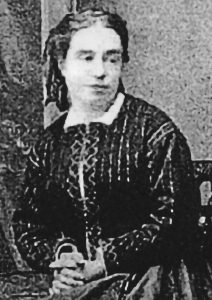
Augustine-Malvina Blanchecotte or Malvina Blanchecotte (1830–1897) was a French poet and writer.
Gisèle d'Estoc, pseudonym of Marie-Paule Alice Courbe, was a French writer, sculptor, and feminist. She was also a duellist and cross dresser. Madame Paule Parent Des Barres was either her married name or another pseudonym, while her pen names included, Gyz-El and G. d’Estoc.
Joséphine Colomb was a 19th-century French children's writer, lyricist, and translator who signed her works, Mme J. Colomb or Mme Louis-Casimir Colomb. She was a recipient of the Montyon Prize (1875) for La fille de Carilès. In 1893, she was a recipient of the Jules-Favre Prize. Colomb died in 1892.

Henrietta Consuelo Sansom, Countess of Quigini Puliga was a French writer and novelist known better by the pseudonym, Brada, a shortened version of her earlier pen name, Bradamente. She also wrote on occasion as Mosca. In 1925, she was appointed Chevalier of the Legion of Honour. The Académie Française awarded her the Montyon Prize in 1890, the Jouy Prize in 1895, and the Xavier Marmier Prize in 1934.